WWII Hospital Ship – MS Oranje
This story was sparked by a couple of images in the PMHPS Collection taken by Roy Liebig in the 1940s. Both images appear later in this story so more on those later.
The MS Oranje started life in the late 1930s as a Nederlandsche Stoomvaart Maatschapij (Netherlands Line) passenger ship operating between Amsterdam and the Dutch East Indies (Indonesia) but in February 1941 Mr T Elink Schurman, Consul-General for the Netherlands, announced that the ship had been handed over to the British Government to be used as a hospital ship to carry Australian and New Zealand troops from the Middle East.
Having been converted in Sydney, the Oranje completed her maiden voyage as a hospital ship berthing at Melbourne in September 1941 with 630 wounded and invalided troops on board. Reports in the newspaper noted that the Oranje, the Pride of Holland, was regarded as the fastest motor-ship in the world and had completed the trip from Egypt in a record, 11 days and 18 hours.
The Oranje made 41 voyages as a hospital ship over the remaining years of the war carrying wounded troops from places such as England, Italy and India back to Australia. She completed her final war-related trip to Australia in November 1945.
There appears to be at least one voyage that captured the imagination of the people of Melbourne and I am going to speculate that the following two photos were taken when the Oranje berthed at Princes Pier on Sunday, 30 September 1945. Notation on the reverse side of the prints identifies them as crowds in Port Melbourne to welcome the Oranje but they are undated.
On the day before the arrival, the Argus reported that the Oranje would berth at Princes Pier at 9.00 am carrying 302 prisoners-of-war from Singapore and that the pier would be closed until all troops had disembarked. The troops would then be conveyed to the Heidelberg Military Hospital via ambulances and RACV cars. Provision had been made for the next-of-kin to meet their loved ones at Heidelberg.
On the day, however, when the gates were opened to let an ambulance off the pier the crowd rushed past the guards and swarmed excitedly to the convoy of cars carrying the POWs distributing sprigs of wattle, flags, kisses, hugs and handshakes indiscriminately. It is estimated about 1,000 of the 9,000 strong crowd who had gathered to greet the men got onto the pier.
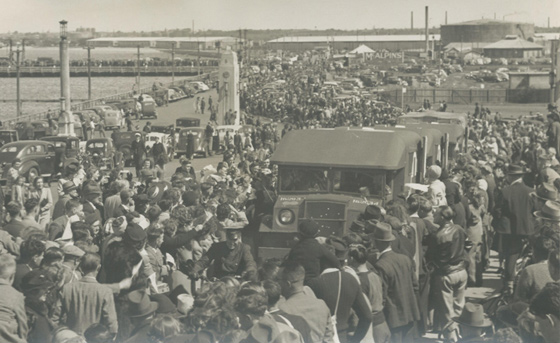
This photograph by Roy Liebig shows the convoy of ambulances making their way over Centenary Bridge carrying men from the Oranje berthed, out of view, at Princes Pier. There was a similar scene when the ambulances arrived at the Heidelberg Military Hospital.
The final photograph by Roy Liebig that I want to highlight is the one that grabbed my attention in the first place because it opens a wonderful window on Port Melbourne perhaps within a month of the end of WWII.
Again, I believe the photograph was taken on 30 September 1945 when the Oranje returned with POWs from Singapore.
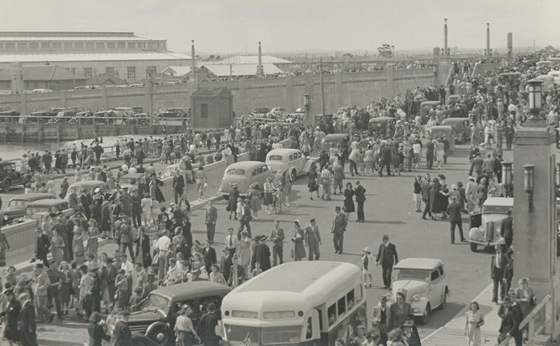
It shows many people walking on the ‘third-leg’ of Centenary Bridge that led down to Station Pier. Perhaps they are returning to their vehicles having watched the returned men make their way through the throng of people elsewhere on the bridge and along the foreshore. Those standing at the railings on the left of the photo, in front of the small substation and triangle beach all seem to be looking towards [the Oranje at] Princes Pier.
After the war the Oranje returned to Amsterdam and was refitted as a luxury passenger liner resuming her place on the Batavia service in July 1946 and by the 1950s was making regular visits to Australia and New Zealand. The Oranje made her final voyage as a Dutch liner on an around the world trip leaving Amsterdam on 4 May 1964 visiting Melbourne again on 3 June.
The Oranje was subsequently purchased by Italian shipping company, Flotta Lauro Line and taken to Italy where she was effectively rebuilt as a ultra-modern liner, renamed the Angelina Lauro and again sailed between Europe and Australia/New Zealand. She came to Melbourne one last time in May 1972 as the Angelina Lauro and returned to Italy via Sydney for yet another refit as a Carribbean cruise ship managed by Costa Line, another Italian company.
On 30 March 1979 whilst berthed at St Thomas, US Virgin Islands, tragedy struck the Angelina Lauro when a fire broke out in the aft gallery quickly spreading throughout the rest of the ship. Thankfully most of the passengers and crew were not on board at the time and those on the ship were able to escape the fire. She was declared a total loss and sold for scrap to ship breakers in Taiwan. On 21 September 1979, however, having successfully passed through the Panama Canal, the Angelina Lauro started to take on water and sank three days later.
I would like to acknowledge Karen Bowden, grand daughter of Roy Liebig (1897-1968), who, as administrator of her mother’s estate, sorted Roy’s photographs and donated them to appropriate historical societies in 2018. PMHPS was the grateful recipient of 15 of Roy Liebig’s photographs taken during the 1940s in and around the Port Melbourne piers and the wharves along the Yarra.
References
MS ORANJE by Reuben Goossens, viewed 20 May 2021 http://ssmaritime.com/oranje.htm
1941 ‘DUTCH PROVIDE ANZAC HOSPITAL SHIP’, The Argus (Melbourne, Vic. : 1848 – 1957), 10 February, p. 5. , viewed 20 May 2021, http://nla.gov.au/nla.news-article8186909
1941 ‘MAIDEN TRIP BY ORANJE AS HOSPITAL SHIP’, The Mercury (Hobart, Tas. : 1860 – 1954), 10 September, p. 3. , viewed 20 May 2021, http://nla.gov.au/nla.news-article25880348
1945 ‘Hospital Ship Oranje Brings Australians Back Home’, The Argus (Melbourne, Vic. : 1848 – 1957), 9 August, p. 9. , viewed 20 May 2021, http://nla.gov.au/nla.news-article971566
1945 ‘ORANJE HERE TOMORROW WITH P O W’s’, The Argus (Melbourne, Vic. : 1848 – 1957), 29 September, p. 3. , viewed 20 May 2021, http://nla.gov.au/nla.news-article976825
1945 ‘CROWD RUSHES PIER AS ORANJE ARRIVES’, The Argus (Melbourne, Vic. : 1848 – 1957), 1 October, p. 1. , viewed 20 May 2021, http://nla.gov.au/nla.news-article12144543
1945 ‘No title’, The Argus (Melbourne, Vic. : 1848 – 1957), 1 October, p. 11. , viewed 20 May 2021, http://nla.gov.au/nla.news-article12144692

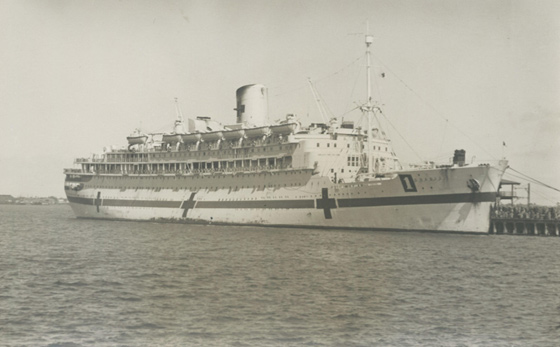
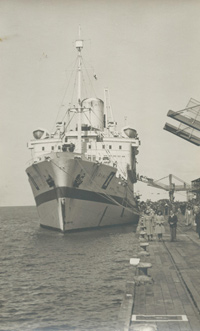
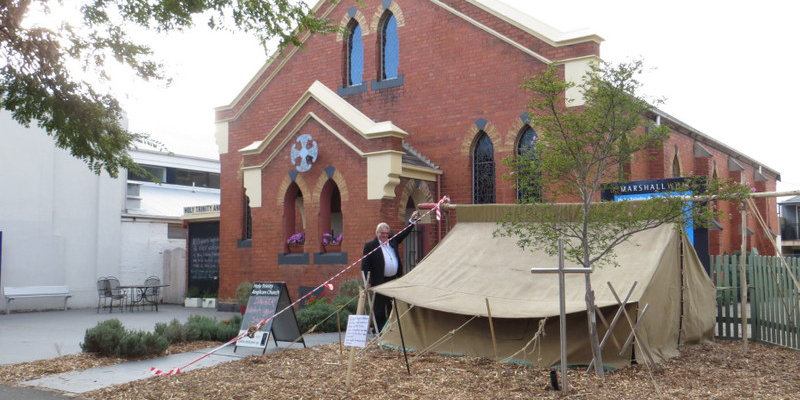
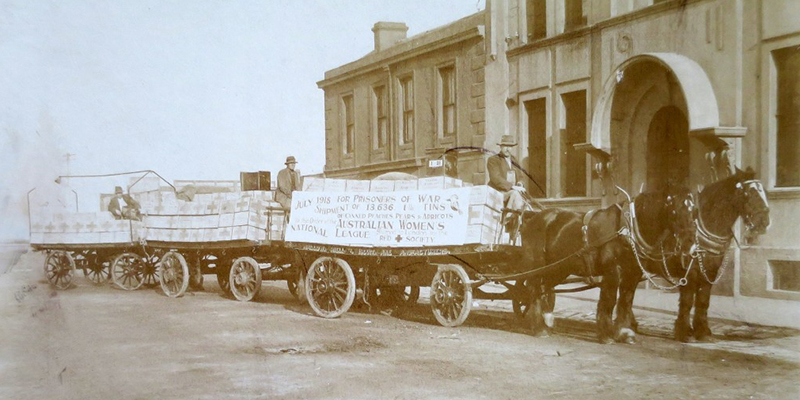
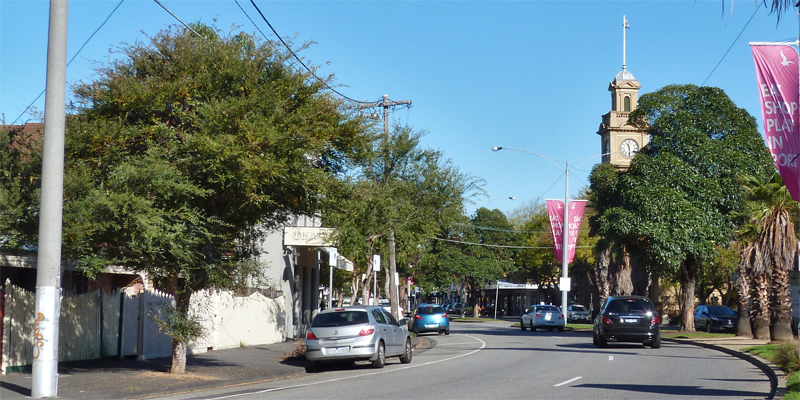
6 Comments
Rosie Bray
One of the saddest days of my life occurred when my mother read in item in The Argus 29/9/1945, which said that the good ship Oranje would be docking in Port Melbourne with wounded service men and women. As my dear dad had been killed in the middle east on June 26 1941, my mum had never come to terms with it.Yes, she had a meager war widows pension, she had seen photos of his grave , but NO mum said dad was still alive, and had so many stories to back her theory. So war widow and her daughter aged 13., went to see if dad was there. We looked at every soldier who came off the ship/saw reunions which nearly broke our hearts—but no Capt Tom Thrupp VX 43987 2/4th Field Reg. It was terrible because we both missed dad so much and it was all so the day that mum came to terms with dad’s death.
So I remember the old Oranje very well, with sadness and tears.
Thank you for the history of this ship and I hope others have happier memories?
David Thompson
Thank you Rosie. I had read the story of you and your mum and the Oranje in your book ’32 Gellibrand Road 3207, Life and times 1941-71′ and I did think of you when I was researching the ship. I hope it hasn’t made you too sad today. Vale Capt Tom Thrupp.
Margaret Bride
Strangely I also remember the return of these men from Singapore. We were living in Creswick at the time. A local man whose name from memory was Rod Taite came home after a spell in the Heidelberg army hospital. I had never seen anyone so emaciated and weak. It made the deepest impression on me, then aged 10.
David Thompson
Thank you Margaret
George Turrell
I arrived at Liverpool on march 18th 1944, at 4 months old from Malta with my Mother on MS Oranje?. Having done some research I was lead to believe it was renamed Aquile Lauro Sister Ship to the one you discribed .Also was it damaged by a German UBoat.
David Thompson
Hi George,
Thanks for adding to the story. According to Wikipedia, perhaps not the best reference, the MS Achille Lauro was originally constructed as the MS Willem Ruys between 1939 and 1946 so it did not sail during the war and was not the subject of a UBoat attack. Famously it was the subject of a hijacking, as the Achille Lauro by the Palestine Liberation Front (PLF) off Egypt in 1985. The Willem Ruys and the Oranje were running mates with Lauro Lines and actually collided in the in the Red Sea in 1953. The Oranje was quite badly damaged but thankfully there was no lost of life. There is nothing on Wikipedia about the Oranje being damaged by a UBoat. The Oranje and Willem Ruys were both sold to Lauro Lines in 1964 and converted to the Angelina Lauro and the Achille Lauro.
https://en.wikipedia.org/wiki/MS_Oranje
https://en.wikipedia.org/wiki/MS_Achille_Lauro